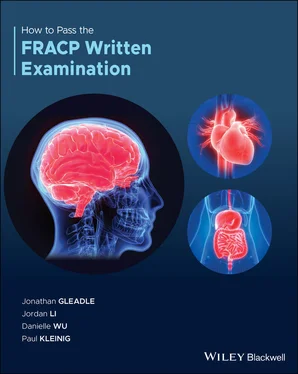https://onlinelibrary.wiley.com/doi/abs/10.1111/imj.14071
33. Answer: A
This patient has an inferolateral STEMI due to multivessel coronary disease. CABG is indicated in patients with severe left main coronary artery disease or triple vessel disease. CABG offers improved survival and quality of life for patients with more extensive coronary disease with reduced left ventricular systolic dysfunction and remodelling. Furthermore, patients with diabetes and multivessel disease have been shown to benefit from CABG.
Percutaneous coronary intervention (PCI) may be considered for patients with multivessel coronary artery disease who are not a candidate for open heart surgery due to comorbidities and poor functional status. PCI even with biventricular pacemaker–defibrillator is not the best option for this patient. He is young; stage 3A CKD and treatment with adalimumab are not contraindications for CABG.
Infarct‐related artery (IRA) or culprit‐only revascularisation in primary PCI is associated with higher rate of long‐term major adverse cardiac events (MACE) compared with multivessel treatment. Patients scheduled for staged revascularisation experienced a similar rate of MACE to patients undergoing complete simultaneous treatment of non‐IRA.

Pineda AM, Carvalho N, Gowani SA, Desouza KA, Santana O, Mihos CG, Stone GW, Beohar N. Managing Multivessel Coronary Artery Disease in Patients With ST‐Elevation Myocardial Infarction: A Comprehensive Review. Cardiol Rev. 2017 Jul/Aug;25(4):179–188.
https://pubmed.ncbi.nlm.nih.gov/27124268/
34. Answer: D
Troponin is a protein complex of three subunits (T, I, and C) that are involved in the contractile process of skeletal and cardiac muscle. Both cardiac and skeletal muscle express troponin C; whereas troponin T and I are cardiac‐specific. Cardiac troponin (cTn) is integral to the diagnosis of acute coronary syndrome (ACS), but is elevated in many patients without ACS.
Conditions associated with non‐ACS cTn elevations include:
Tachyarrhythmias
Congestive heart failure
Malignant hypertension
Sepsis
Myocarditis
Valvular heart disease (aortic stenosis)
Aortic dissection
Pulmonary embolism, pulmonary hypertension
Chronic kidney disease
Acute ischaemic or haemorrhagic stroke
Cardiac contusion or cardiac procedures (CABG, PCI, ablation, pacing, cardioversion, or endomyocardial biopsy)
Infiltrative diseases (amyloidosis, hemochromatosis, sarcoidosis)
Myocardial drug toxicity or poisoning (doxorubicin, trastuzumab, snake venoms)
Rhabdomyolysis.
As cTn can be detected among healthy adults, there are guidelines regarding what is considered an ‘elevated’ level. The joint European/American College of Cardiology guidelines define a clinically relevant increase in cTn levels as a level that exceeds the 99th percentile of a normal reference population. However, using a statistical cut‐off means that some normal individuals will have a value above this cut‐off, and because other clinical causes can cause an elevation, cTn should be interpreted in the context of pre‐test probability of ACS. cTn concentrations are elevated in one in eight patients in the emergency department (ED).
High‐sensitivity assays can accurately detect cTn at lower levels than older‐generation assays, giving them higher sensitivity for the detection of ACS at presentation, which means that the time interval to the second measurement of high‐sensitivity cTn (hs‐cTn) can be significantly shortened, thereby reducing the time to diagnosis and improving efficiency in the ED. There is concern that hs‐cTn may have lower diagnostic accuracy in patients with low pre‐test probability for ACS. Concern of misinterpretation of these hs‐cTn elevations as ACS and patient harm associated with potential unnecessary therapies such as anticoagulation and coronary angiography has led some experts to recommend withholding hs‐cTn testing in patients with a low pre‐test probability for ACS.
However, practice guidelines also highlight that ACS frequently presents with atypical symptoms especially in the elderly and patients with diabetes. It recommends scrutiny for ACS with ECG and hs‐cTn. These divergent recommendations result in uncertainty in clinical practice regarding hs‐cTn testing in patients with low pre‐test probability for ACS. A recent retrospective analysis reported low specificity for hs‐cTn to diagnose MI when grouping ED patients with suspected MI together with patients with acute heart failure and patients with documented PE. Hence, it is very important to highlight that diagnostic testing with hs‐cTn should be applied to the correct population, at the optimal time and in the appropriate clinical context. This patient has very low pretest probability because her epigastric discomfort is nonspecific; her renal function is normal, and there are no other cardiovascular risk factors.

Twerenbold R, Boeddinghaus J, Nestelberger T, Wildi K, Rubini Gimenez M, Badertscher P et al. Ref: JACC 70(8):996–1012.
Clinical Use of High‐Sensitivity Cardiac Troponin in Patients With Suspected Myocardial Infarction. Twerenbold et al.
2017;70(8):996–1012.
https://pubmed.ncbi.nlm.nih.gov/28818210/
35. Answer: B
This elderly woman is septic due to severe pneumonia. She has multiple cardiovascular risk factors. Her ECG shows ischaemic change, and the troponin level is elevated. This is a typical case of type 2 myocardial infarction (MI).
MI can be classified into various types, based on pathological, clinical, and prognostic differences, along with different treatment strategies:
Type 1: Spontaneous myocardial infarction
Spontaneous MI related to atherosclerotic plaque rupture, ulceration, erosion, or dissection with resulting intraluminal thrombus in one or more of the coronary arteries leading to decreased myocardial blood flow or distal platelet emboli with ensuing myocyte necrosis. The patient may have underlying severe coronary artery disease (CAD) but on occasion non‐obstructive or no CAD.
Type 2: Myocardial infarction secondary to an ischemic imbalance
In instances of myocardial injury with necrosis where a condition other than CAD contributes to an imbalance between myocardial oxygen supply and/or demand, e.g. coronary endothelial dysfunction, coronary artery spasm, coronary embolism, tachy‐/brady‐arrhythmias, anaemia, respiratory failure, hypotension.
Type 3: Myocardial infarction resulting in death when biomarker values are unavailable.
Type 4a: Myocardial infarction related to percutaneous coronary intervention (PCI).
Type 4b: Myocardial infarction related to stent thrombosis.
Type 5: Myocardial infarction related to coronary artery bypass grafting (CABG).
Patients with type 2 MI are frequently encountered in clinical practice and may be more common than type 1 MI. Diagnostic criteria for type 2 MI include:
Detection of a rise and/or fall of troponin values with at least one value above the 99th percentile, and evidence of an imbalance between myocardial oxygen supply and demand unrelated to acute coronary atherothrombosis, requiring at least one of the following:
Symptoms of acute myocardial ischaemia
New ischaemic ECG changes
Читать дальше














